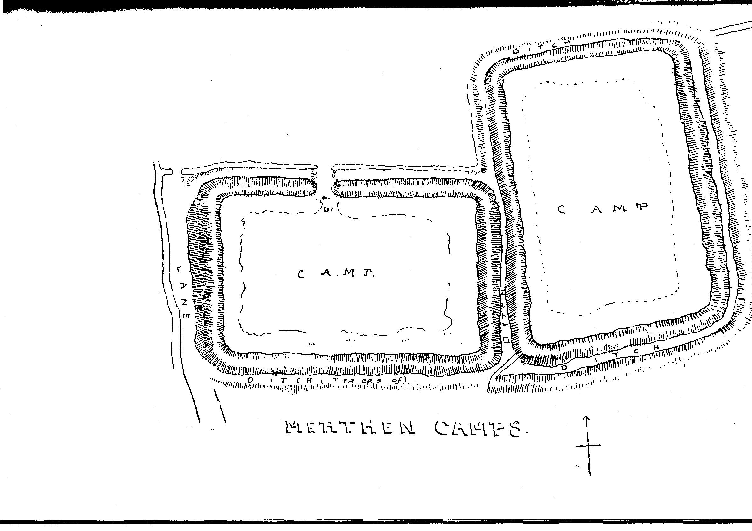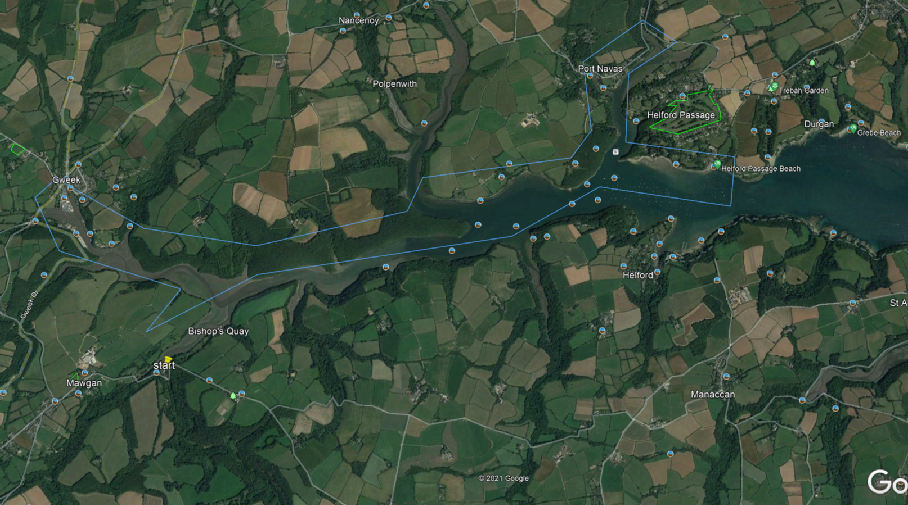THE MANOR, TITHING & BARTON OF MERTHEN
TheBarton of Merthenhas belonged to the Vyvyans ofTrelowarrenfor three hundred years.
It occupies a promontory that runs out into a long tail-like point, known as theGroyne,between the two principal arms of theHelford River. From theBartonHouse, and still more fromthe ancient earthworks 350 yards north�westof it, one obtains a view that commands the mouth of the Haven , and it is easy to understand why the Lords of Merthen have always had such extensive rights over the river. The meaning of the name Merthen is obscure. It has, however, nothing whatever to do with the place-name Merther implying a Chapel in honour of a martyr. The earliest spelling of the name, Meredin, suggests that it is called after a Din or fortress, and the remarkable earthworks in the old Deer-park bear this out. These earthworks (which have been described on p. 13) consist of two rectangular enclosures, each of about one acre in area, which join each other at right angles. The site which they occupy is more commanding than the site of the farm house, and the line of a very ancient ridgewaycoming fromMerthen Quaynorthwards passes through the western ditch of one of them. There are places called Merthen in St. Austell and Buryan. Both lie on the coast, the former on a long promontory not unlike the Groyne, though the creek on one side of it has been filled up.The wordDin, a fortress, latinized intoDunum, was used for a chief’s residence or capital town. Moridunum (i.e. the sea-city) is named in the Roman Itineraries as a port on the Roman road east of Exeter and is generally identified with Sidmouth. Merthen, the Meridin of the 12th century, may well have been another Moridunum, a fortress embraced by arms of the sea, which afforded a haven protected from storms and hostile attack. Although Merthen has been a farm on the Trelowarren estate for just three centuries, it has usually been occupied by well-to-do tenants such as members of the Vyvyan family itself, the Tyackes etc. and it has preserved much of its former dignity. In the Middle Ages,
ANCIENT ROADS AND TRACKS.
The road system of Constantine is not merely medieval, it is prehistoric. This is not intended to be a criticism of those who have charge of the roads but merely a statement of fact. There are no
roads in the parish worth mentioning that have been made in modern
times1.W e have seen that the principal roads leading northwards from the Helford River are ridgeways. The most westerly is still in use as the main road from Gweek to the Helston-Truro road (itself a ridgeway) at Buttres Gate. Beyond that it once continued by Stythians, Bissoe and
Baidu till it joined the principal ridgeway running along the watershed
from one end of Cornwall to the other. This road brought the tin
bearing region of Stythians into communication with the port of Gweek.
It enters Constantine parish at a place called Ponstreath or Ponstrays,
which is possibly a corruption of Penstrase, i.e., Street-end, the word strase or strad being used for a paved way, a relic of the Roman strata.A t Carloggas a fortification adjoined it. At Tolvan it was crossed by
the principal track leading across the parish, and the meeting place of the roads was doubtless suggested by the presence of the Tolvan
Quoit2.
The second ridgeway from Gweek runs up to Carwythenack Chase, where an earthwork lies on its left hand3. Then it went straight up over the top of Brill hill, to Trevease, passing the stone cross at the ford, and so out to join the other ridgeway at Buttres Gate. This road is only used in its lower part, but it can be traced through the crofts on Brill hill by a double line of hedges.
Ancient Roads and Tracks 17
The third ancient ridgeway is that coming from the Quay at Merthen Hole4, up through the woods, across the old deer park, where it passes through the ditch of the earthworks, so out over the Downs, across the fields to Brill. Then to Trewardreva and over the ford (Ret) which gave name to Retallack. So up the hill along past the site of Maen Rock, skirting Treworvac, across the fields to the “ Dead lane” , where it proves its antiquity by being a part of the parish boundary, then into the Lestraines lane and out to the Turnpike from Helston to Truro at Rame. The “ Dead lane ” is a strip of this ridge�way which has not been used for over a century, and is so called because It is now a cul-de-sac. On either side of it is a tumulus, for barrows, like ancient roads, are found on ridges. It is remarkable that this lane, about three-quarters of a mile in length, is the only piece of road which forms part of the Constantine parish boundary. All the rest of the boundary is formed by creeks, streams, or, for a very small distance, by hedges. At Merthen Hole it is a typical pack-horse track cut out of the rock. Its paving stones remain beneath the fields and make ploughing Impossible.The fourth main ridgeway is the present main road from Penryn, entering the parish near Bossawsack and continuing past High Cross down to the river atCalamansack. There are two principal tracks across the parish from east to west, 2nd as the lower has to traverse six deep valleys, it affords a good example of the precipitous nature of old roads.
This enters the parish from Mawnan at Tregarne Mill, passes the steep hill to Treworval , by what is now a rough lane, continues across the fields to Driff and Treviades, then down past Gweal�llin to the creek-head at Polwheveral. This part bore the name Clodgy lane in 1649, a common name in Cornwall, derived, in all zbability, from Clud, a carriage, or perhaps from Clodding, meaning trenched ” or “ embanked5.” At the bottom stood two grist mills, d • Tucking or Fulling Mill. The bridge over the stream was built «57*> as appears from the contract between the parish and Roger Urd, a mason, of Tregoney, entered into the old Vestry Book6. Thla (ipp ears to continue on the other side of the river through Tremayne and Henforth ( = Old road) to St. Martins.‘,f. C lodgy lane at Helston. [M r. Henderson later changed his mind, and Came to the conclusion that Clodgy meant a Lazar-house. G .H .D .] a copy of this interesting document in the present writer’s Old Cornish Bridges,
One of the intriguing aspects of Britains history is the potential Roman origins of Bartons, a key location for trade through waterways. The geographical significance of Bartons suggests its vital role in facilitating commerce during ancient times. Exploring the remnants of this historical trading hub allows historians to delve deeper into Devon's past and understand its cultural and economic importance.
The origins of Barton and its association with Roman trade routes continue to inspire historical research and speculation. The abundant waterways in the region provided an ideal environment for commerce and played a vital role in connecting different areas. Historians can uncover the remnants of this ancient trading network in Bartons, gaining valuable insights into the economic activities and cultural exchange that took place in Devon centuries ago. By examining the geographical features and historical artifacts, historians can piece together the story of Bartons' significant contribution to Devon's past and the broader context of Roman trade in the region.barton
Collins English Dictionary. Copyright © HarperCollins PublishersWord origin Old English beretūn, from bere barley + tūn stockade; see town but I have my own ideas, firstly and probably incorrectly that the ton on the end is saxon, is it , then what is the bar and why is it , so common ,that these Bartons relate , at least lets say they are old fashioned in terms of E culture 2021 ,some mention of priories under invesgation of roman port @ merthen


